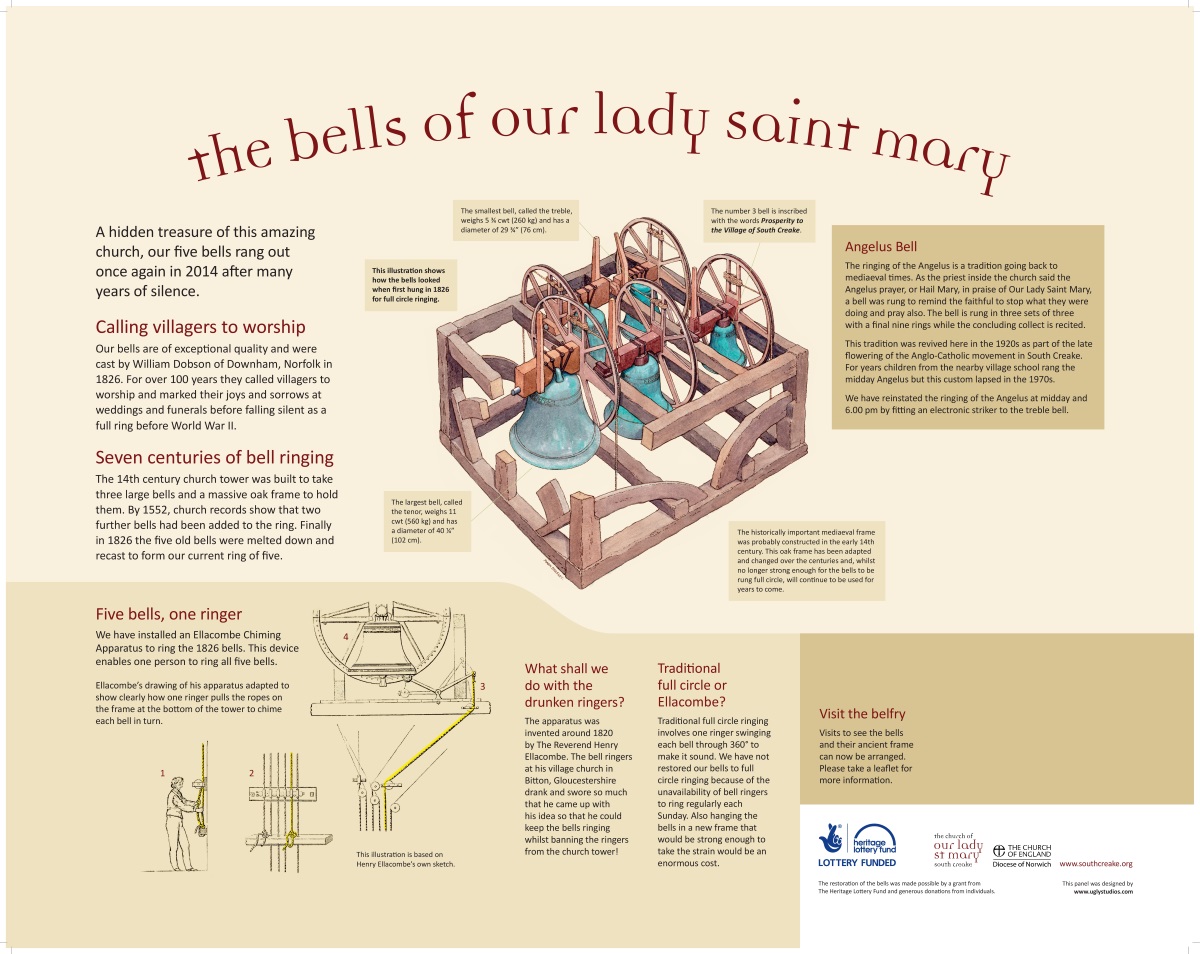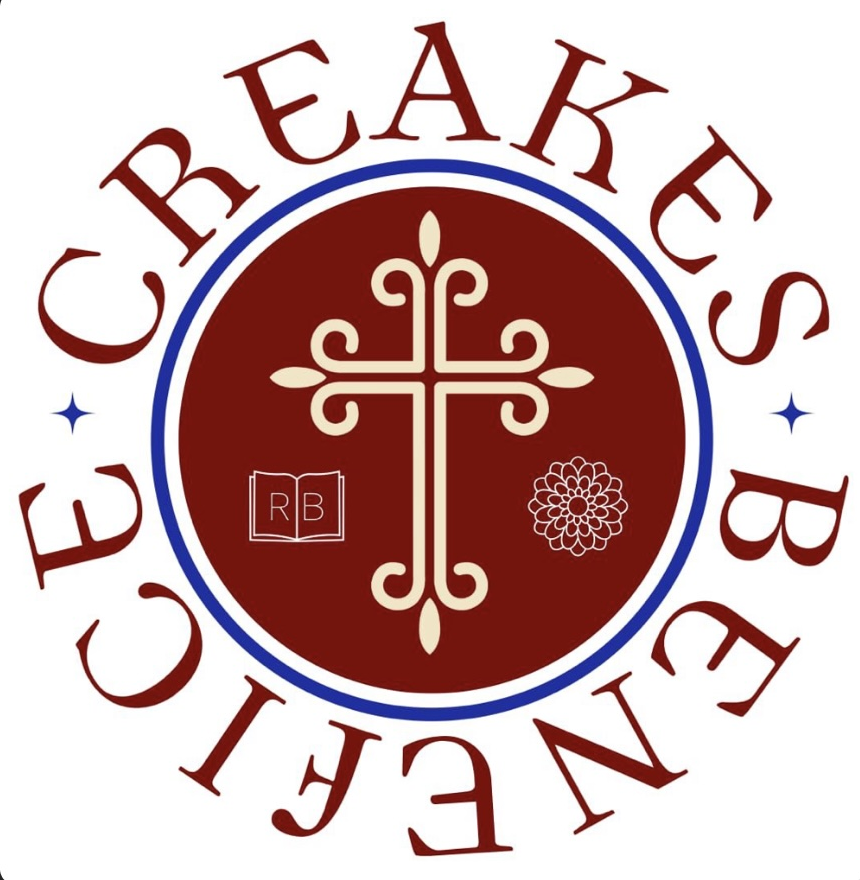History of The Church of Our Lady Saint Mary South Creake
This brief history below of St Mary’s South Creake has been greatly expanded and was published in March 2011 in book form as A Church in a Landscape – A history of South Creake church by Fr Roger Arguile.
The Age of Church Building
The story of South Creake·parish church begins about 900 years ago with the building of a private chapel by the Beaufoe family, who had been given land in the village by King Henry I. Like many godly folk, they gave the church away to a monastery, Castleacre, whose ruins can be seen off the Fakenham to Swaffham road. Castleacre is known for having rebuilt its churches and the present chancel dates from those early days.
The first church was built of wood. The monastery, in all probability, rebuilt it in stone though little of what they built remains. The late thirteenth and early fourteenth centuries saw the expansion of many churches with much larger windows, early English and Decorated in style, with a larger nave roofed, it is said, with thatch, and a tower. The tower lacks a parapet, perhaps because it was never completed, for the century saw a number of upheavals: a series of poor harvests, the wars with the French, the Black Death, which started in 1348 and continued on and off for decades, and the Peasants Revolt of 1381. The dislocation in parish life accelerated the decay of the manorial system: more men became free tenants, no longer tied to the land some migrated to the towns, less labour intensive sheep farming increased.
The hundred years or so that followed were times of growth and development. The dynastic wars of the Roses did not impinge much on parish life; indeed it was a time of rebuilding, a sure indication of stability and prosperity. The nave was rebuilt with larger windows in the perpendicular style, a less steep slate roof with clerestory windows and, internally, the angel roof and the rood screen with its staircase. This was not merely an increase in grandeur; it was a change of piety.· The great rood, a statue of Christ on the cross set in the chancel arch, dominated the church; the holy week ceremonies which took place before it testify to a particular devotion to the Passion.· Local gilds, religious rather than craft organisations, of which there were five in the village, tended their individual altars, raised money for the building and for local causes. Holy days were holidays and processions dignified them, as eating and drinking, ‘church ales’, provided a different kind of solace.
Disruption and Reform
All this was swept away in a very few years by the process which we have come to know as the Reformation.· In 1537, Castleacre monastery surrendered itself to king Henry VIII; ten years on his death, all the decorations in the church were removed: statues and altars were smashed, the Rood torn down, vestments and church plate sold; processions were banned, saints’ days abolished. Henry’s three children, who ruled one after the other, had different religious views: Edward pushed the Reformation forward; Mary, his half sister, a Catholic, made the people of South Creake, and everywhere else, put back their statues, their Rood, and their stone altar; Elizabeth made them take them down again. What drove them was a combination of a process of thought, a political agenda and a desire for reform.· Many people of different theological views were in favour of the removal of corruption; a more rigorous turn of mind wished to cut out legendary and superstitious elements of the faith; fresh impetus was given to it by hostility to the power of the papacy by increasingly assertive monarchs and the new biblical scholarship by which many practices were put in question. The effect upon local parishes was wholesale destruction within the church, a word-dominated liturgy and a much more centralised system of governance outside it. The local church became an instrument of government, recording births, marriages and deaths, administering the poor law and taking responsibility for roads.
This was not the end of turmoil. After Elizabeth’s death in 1603, the polarisation between those who affirmed the old regime and those who pressed for further change increased. The Civil War was a continuation of the reformation by other means. With the Commonwealth of Oliver Cromwell, the no-longer-quite-new prayer book was made illegal, the bishops were sacked; many places had no priest at all for long periods of time and competing chapels were set up. South Creake was rare in having a priest who ministered throughout the period and who may have clandestinely ignored government prohibitions.
Restoration and Social Change
The Restoration began in 1660 with the return of the monarch, but the Church was now one of several denominations and little was done to restore either the building or its life.· It remained an administrative unit of some importance, dealing with the poor and the insane, even acting as a court of morals in matters of fornication, adultery, intoxication and neighbour disputes; but theology, the focus of such violence and disagreement over more than a hundred years, was superseded by other ideas.· The new interest in science and the search for truths independent of belief, the so-called Enlightenment, began to take hold.· South Creake saw no changes, internal or otherwise; it witnessed no liturgical developments: there were none.· Instead, the village was affected by the shortages following the French Revolution and the Napoleonic wars and the social changes which accompanied them, which were some of them the children of the Enlightenment.· But the enlightened were not all of them kind.· Enclosure drove men off the land and made them rootless labourers; machines began to deprive them of their means of employment; at any rate the villages around South Creake saw an upsurge of rioting, arson attacks and animal maiming which was at its greatest extent during the 1830s but which continued for some time afterwards.
The theological response to this was not found within the church but in the growth of Primitive Methodism.· This manifestation of religion was simple, proletarian and closely related to the trades union movement.· Preachers and trade union organisers were often the same people; chapels sprang up in almost every village.· The church meanwhile, through its collection of the tithe, was more closely associated with landowning.· By 1851 the two chapels in the village had a higher attendance between them than did the church.
The church’s major social contribution was elsewhere; the poor had become the responsibility of the union workhouse to which the clergy made some contribution locally, by demanding higher standards of care; but it was in the building of schools that the church made its mark, often, as in South Creake, against the resistance of local landowners.· The picture is mixed, but South Creake’s school was established in 1859 and flourished for more than a century, mostly administered by the clergy.
The increasing sophistication of local government and the administration of services led progressively to the marginalisation of the church in the village as elsewhere.· Clergy had been farmers; they then became gentlemen; by the First World War they were unregulated professionals.· The patriotism of the parson in the village contributed to the welfare of returning soldiers and the support of grieving families but resulted in a sense of exhaustion.· The church had little social influence outside education as the increasing mechanisation of agriculture drew men from the land.· The process was slow but religion had become a voluntary affair.
The Anglo Catholic Revival
It was not until 1921 that another counter-movement of thought within the church reached the village.· The Oxford Movement dates from 1833, with a resistance within the church to state control. It was combined with an interest in the pre-Reformation origins in the church and an interest in liturgy and church architecture.· The new priest, as such he styled himself, had within six months moved the church from a combination of morning prayer and holy communion said with hymns to weekly high mass with incense and bells, sung wearing coloured vestments.· Statues of the saints followed. And the congregations more than doubled.· That was to be the pattern over the following decades, though congregations responded both positively and negatively to the generosity of spirit, or its absence, on the part of the succession of clergy in the village.· Attention to the church building, often neglected in the past, was their forte; often eccentric, they beautified the building so that it became a shrine not just a meeting place.· In 1982, a rood, the aspiration of several generations, was installed.
Latterly, the fall in the number of clergy has been paralleled by the transformation of village life. The vicar now cares for four churches instead of one, and they of very different theological colour. Over a third of the houses are owned by those who live and work elsewhere.· The Anglo-Catholic movement has been fissured by the ordination of women though the revision of Anglican liturgy owes almost everything to it.
The church now stands at a crossroads. New issues have arisen: from secularisation and consumerism to the reductionist claims of some scientists and the huge impact of the sexual revolution. To these the church will offer its unique contribution to the tradition of worship and prayer, teaching and care which has characterised the church in the past at its best.
Seven Centuries of Bells
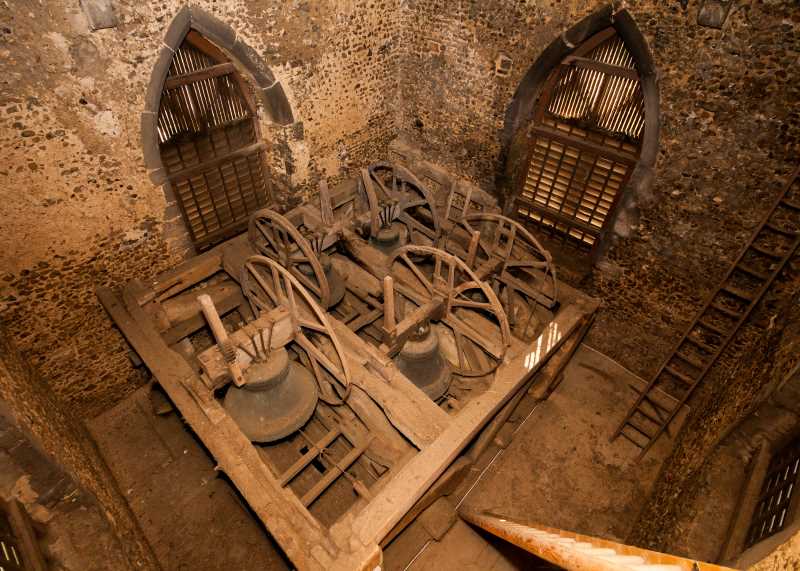
Bells in ringing chamber © Peter Trent
There have been bells at Saint Mary’s since the early fourteenth century when the present tower was built. Originally there were three large bells hung in the massive oak frame that still holds our bells. By 1552 records show that the ring had been augmented with two more bells.
In 1826 those five old bells were removed and the current bells were cast by the respected Norfolk bell founder, William Dobson of Downham, using the metal from the old bells.
The 1826 bells are hung in an extraordinary medieaval frame which is believed to be as old as the 14th century tower itself. Close examination shows how the frame has been adapted over the centuries to meet the needs of the time: the original three large bells, the augmented ring of five, and finally Dobson’s 1826 bells. The frame is well worth seeing in its own right.
Its massive timbers, reminiscent of those of a wooden warship or an ancient mill, are rough hewn and rugged but no longer strong enough to support the bells if restored to full circle ringing.
For over hundred years the five Dobson bells called villagers to worship but even before World War II they had fallen into disrepair and, whilst individual bells were occasionally chimed, they were silent thereafter as a full ring.
What to do about the bells has been on the PCC agenda for years but it was the firm, but quite proper, advice from our Diocesan Bells Adviser, Peter Trent, to cease “clocking” the treble that finally galvanized us. “Clocking” is the bad practice of chiming a bell by tieing a rope to the end of the clapper, to its flight, and pulling the clapper against the inside of the bell. If done carelessly, this can cause the bell to crack as the clapper may be held against the bell after striking, rather than immediately falling away, and intefer with its natural vibration.
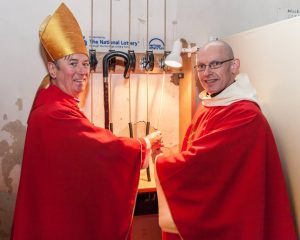
Bishop Jonthan and Fr Clive bless the Ellacombe frame © Peter Bird
In November 2014 an Ellacombe Chiming Apparatus was installed by The Whitechapel Bell Foundry. The apparatus was blessed and the bells re-dedicated by the Bishop of Lynn, The Right Reverend Jonathan Meyrick, on 7 December 2014, as part of a Benefice Confirmation Service. On the preceeding day a Day of Celebration was held, as part of our annual Christmas Fair, during which visitors were taken up the tower to see the bells and a demonstration of hand bell ringing was laid on.
The decision to instal an Ellacombe Chiming Appartus rather than restore the bells to full circle ringing was pragmatic. Full circle ringing would have cost five or six times as much which, with all the demands on our finances, would have been hard to justify. Moreover there is no band of ringers available to ring the bells before service either in the village or locally.
Bells at South Creake
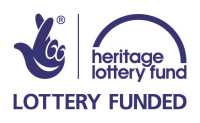 Our five bells are of exceptional quality and until now a hidden treasure of this amazing church. After many years of silence they rang out again on 7 December 2014 to call villagers once more worship and to mark their joys and sorrows at weddings and funerals. The project was possible because of a large Heritage Lottery Fund grant and generous donations from many individuals.
Our five bells are of exceptional quality and until now a hidden treasure of this amazing church. After many years of silence they rang out again on 7 December 2014 to call villagers once more worship and to mark their joys and sorrows at weddings and funerals. The project was possible because of a large Heritage Lottery Fund grant and generous donations from many individuals.
